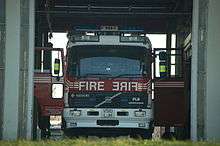Mirror image



A mirror image (in a plane mirror) is a reflected duplication of an object that appears almost identical, but is reversed in the direction perpendicular to the mirror surface. As an optical effect it results from reflection off of substances such as a mirror or water. It is also a concept in geometry and can be used as a conceptualization process for 3-D structures.
In geometry and geometrical optics
In two dimensions
In geometry, the mirror image of an object or two-dimensional figure is the virtual image formed by reflection in a plane mirror; it is of the same size as the original object, yet different, unless the object or figure has reflection symmetry (also known as a P-symmetry).
Two-dimensional mirror images can be seen in the reflections of mirrors or other reflecting surfaces, or on a printed surface seen inside out.
If we look at an object that is effectively two-dimensional (such as writing) and then turn it towards a mirror, the object turns through an angle of 180 degrees and we see a left-right reversal in the mirror. In this example, it is the change in orientation rather than the mirror itself that causes the observed reversal. Another example is when we stand with our backs to the mirror and face an object that's in front of the mirror. Then we compare the object with its reflection by turning ourselves 180 degrees, towards the mirror. Again we perceive a left-right reversal due to a change in orientation. So, in these examples the mirror does not actually cause the observed reversals.
In three dimensions
The concept of reflection can be extended to three-dimensional objects, including the inside parts, even if they are not transparent. The term then relates to structural as well as visual aspects. A three-dimensional object is reversed in the direction perpendicular to the mirror surface. In physics, mirror images are investigated in the subject called geometrical optics.
In chemistry, two versions (isomers) of a molecule, one a "mirror image" of the other, are called enantiomers if they are not "superposable" (the correct technical term, but "superimposable" is also used) on each other. That is an example of chirality (chemistry). In general, an object and its mirror image are called enantiomorphs.
If a point of an object has coordinates (x, y, z) then the image of this point (as reflected by a mirror in the y, z plane) has coordinates (-x, y, z). Thus reflection is a reversal of the coordinate axis perpendicular (normal) to the mirror's surface. In everyday use, a mirror does not reverse right and left (or up and down), but rather reverses front and back. However, there is often a perception of left-right reversal, probably because the left and right of an object are defined by its top and front. Reflection in a mirror does result in a change in chirality, more specifically from a right-handed to a left-handed coordinate system (or vice versa). As a consequence, if one looks in a mirror and lets two axes (up-down and front-back) coincide with those in the mirror, then this gives a reversal of the third axis (left-right). Similarly, if you stand side-on to a mirror your left and right will be reversed directly by the mirror because your left-right is then the direction perpendicular to the mirror plane. It's important to realise there are only two enantiomorphs, the object and its image. So, no matter how the object is oriented towards the mirror, all the resulting images are fundamentally identical, as Professor M.Corballis has written in his paper "Much ado about mirrors" (see "External links", below). In the photograph of the urn and mirror (top right of this page), the urn is fairly symmetrical front-back and left-right. So, it's not surprising that no obvious reversal of the urn can be seen in the mirror image.
A mirror image appears more obviously three-dimensional if the observer moves, or if viewed using binocular vision. This is because the relative position of objects changes as the observer's perspective changes, or is different viewed with each eye.[1]
Looking through a mirror from different positions (but necessarily with the point of observation restricted to the halfspace on one side of the mirror) is like looking at the 3D mirror image of space; without further mirrors only the mirror image of the halfspace before the mirror is relevant; if there is another mirror, the mirror image of the other halfspace is too.
Effect of mirror on the lighting of the scene
A mirror does not just produce an image of what would be there without it; it also changes the light distribution in the halfspace in front of and behind the mirror. A mirror hanging on the wall makes the room brighter because additional light sources appear in the mirror image. However, the appearance of additional light does not violate the conservation of energy, because some light is missing behind the mirror as the mirror simply re-directs the light energy. In terms of the light distribution, the virtual mirror image has the same appearance and the same effect as a real, symmetrically arranged half-space behind a window (instead of the mirror): Shadows may extend from the mirror into the halfspace before it, and vice versa.
Mirror writing
In mirror writing a text is deliberately displayed in mirror image, in order to be read through a mirror. For example, emergency vehicles such as ambulances or fire engines use mirror images in order to be read from a driver's rear-view mirror. Some movie theaters also take advantage of mirror writing in a Rear Window Captioning System used to assist individuals with hearing impairments watching the film.
Systems of mirrors
In the case of two mirrors, in planes at an angle α, looking through both from the sector which is the intersection of the two halfspaces, is like looking at a version of the world rotated by an angle of 2α; the points of observations and directions of looking for which this applies correspond to those for looking through a frame like that of the first mirror, and a frame at the mirror image with respect to the first plane, of the second mirror. If the mirrors have vertical edges then the left edge of the field of view is the plane through the right edge of the first mirror and the edge of the second mirror which is on the right when looked at directly, but on the left in the mirror image.
In the case of two parallel mirrors, looking through both once is like looking at a version of the world which is translated by twice the distance between the mirrors, in the direction perpendicular to them, away from the observer. Since the plane of the mirror in which one looks directly is beyond that of the other mirror, one always looks at an oblique angle, and the translation just mentioned has not only a component away from the observer, but also one in a perpendicular direction. The translated view can also be described by a translation of the observer in opposite direction. For example, with a vertical periscope, the shift of the world is away from the observer and down, both by the length of the periscope, but it is more practical to consider the equivalent shift of the observer: up, and backward.
It is also possible to create a non-reversing mirror by placing two first surface mirrors at 90 degrees to give an image which is not reversed.
See also
- Chirality, a property of asymmetry important in several branches of science
- Flipped image
- Flopped image
- Handedness
- Plane mirror
- Reflection (physics)
- Relative direction
| Wikimedia Commons has media related to Symmetric images. |
References
- ↑ Adams, Cecil (1985-09-27). "Are dogs unable to see 2-D images (mirrors, photos, TV)?". The Straight Dope. Retrieved 2008-01-31.
External links
- Why do mirrors reverse images left to right? Why not up and down?
- The same question explained a little differently, with examples
- Why do mirrors flip horizontally (but not vertically)?
- "Much ado about mirrors" (an academic paper about the psychology involved in the perception of mirror images)